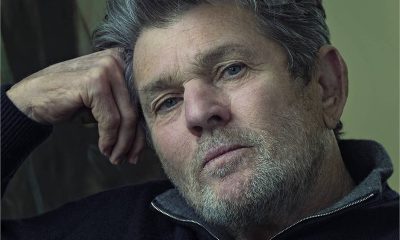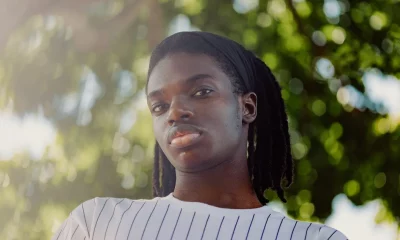a&e features
A ‘Joy’-ful outlook
Isabella Rossellini muses on her accidental career and gay credibility
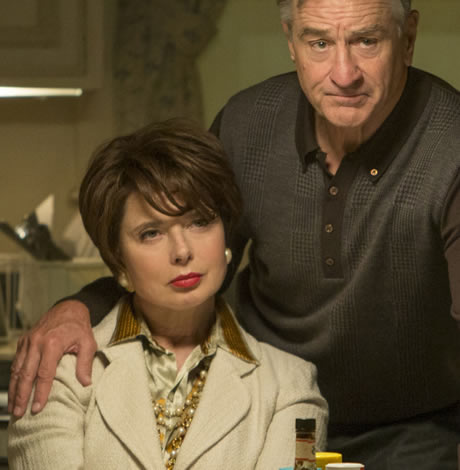
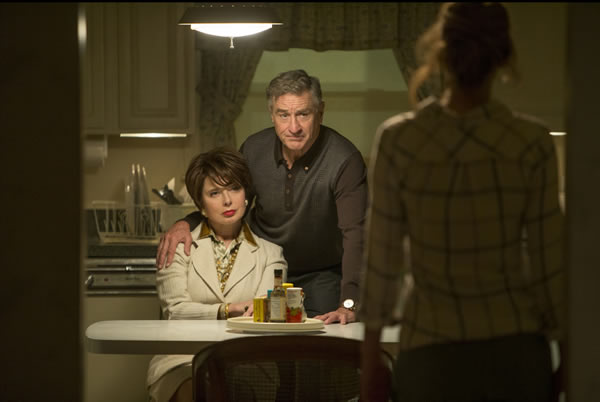
Isabella Rossellini with Robert De Niro in ‘Joy.’ (Photo by Merie Weismiller Wallace; courtesy Twentieth Century Fox)
Isabella Rossellini is leading me into the light.
There, in front of an almost full-wall window in a hotel suite at the Mandarin Oriental hotel in New York City, we stand beaming as her assistant snaps a pic. Good lighting is everything, as Rossellini notes in her thick Swedish-Italian accent — otherwise, “it’ll get all black.”
She should know. Rossellini embarked on a career in front of the camera when, at the age of 28, the classic Rome-born beauty fell into modeling, hawking Lancôme as the company’s spokeswoman for 14 years and posing for an array of eminent celeb photographers, including Annie Leibovitz and Robert Mapplethorpe.
“When I worked with him, he was quite sick with AIDS,” Rossellini says. “I remember how sad I felt, because he was very handsome and he celebrated in his photos the male body, the human body and to see him paying such a toll, not even just physically. But he seemed to be in good spirits. I wondered … of course he knew he was dying. It was a very difficult time, the ’80s. And it was the last book that he made. They wanted him to photograph women and he did beautiful portraits of several women.” (Also featuring Yoko Ono and Susan Sarandon, “Some Women” was published in 1989, the same year Mapplethorpe succumbed to AIDS-related illness.)
Rossellini’s striking appeal wasn’t only dark room-worthy, however.
While modeling, Rossellini also began mirroring the career of her iconic mother, Ingrid Bergman (Rossellini’s father is Italian director Roberto Rossellini), reaching beyond the glossy pages of Vogue to become a film star. As abused nightclub vocalist Dorothy Vallens in David Lynch’s 1986 trippy thriller “Blue Velvet,” a role that required Rossellini to sing, Mapplethorpe’s muse demonstrated more than a pretty face — she could really act.
Rossellini also happens to know a lot about animal sex. In 2008, she directed, produced, wrote and starred in a series of short films for Sundance titled “Green Porno,” illustrating the various mating acts of insects and other non-humans with, of course, cardboard and foam rubber. And if you ever wondered how dolphins do it (who hasn’t?), the actress also created the 2014 web series “Seduce Me,” wherein she discusses “blowhole sex” as she pseudo swims in a diorama-inspired scene among some very frisky Flippers.
Rossellini’s latest is certainly less niche. In director David O. Russell’s “Joy,” the veteran actress is back on the big screen as Jennifer Lawrence’s affluent, finger-wagging stepmom, Trudy, a tough-love foil to the based-on-real-life titular character.
“It’s empowering to women,” Rossellini says, nuzzled into the corner of a sofa, “and it’s also about the struggle of success. Generally when a person is successful people imagine, ‘Oh, overnight success, luck,’ instead of how arduous it is. The film portrays it very well. Family encourages you and discourages you because they are protective.”
Though Rossellini recognizes Joy’s unwavering ambition to seize businesswoman status — a path she blazes after inventing a fancy mop — her own life, she says, has been “completely different,” a truth she attributes to her European background as well as her famous film industry family.
“You know, I was more successful than I thought I’d be,” she says. “I’m old enough to have belonged to a group of women who thought, ‘I’m gonna get married and be a housewife.’ Instead, a career came, and it was really modeling — modeling is almost like winning the lottery.”
Rossellini’s modeling career continued to blossom in the ’80s, when she graced the covers of countless women fashion mags: Marie Claire, Harper’s Bazaar, Vanity Fair and Elle. She could’ve been a stay-at-home mom. She could’ve cleaned and cooked and called it a day. And she thought, for many years, she would. But in her 30s, she changed her mind.
“I understood that being financially independent meant also to be independent,” she says. “You don’t really do anything to become a good model. You’re either chosen or not chosen, liked or not liked. If you are a bitch, they’re not gonna hire you anymore. And modeling really teaches you the discipline of work. So modeling for me was a wonderful revelation. Though my mother worked — my mother was Ingrid Bergman, had a big career — it was seen as she had a gift, she had a talent, that it was extraordinary. It was a kind of a call for her, but it wasn’t percolating down to the family that all the women should have a career, no.”
In 1976, Rossellini shot her movie debut, playing a minor role in her mother’s film “A Matter of Time.” Ten years later, Rossellini became an icon in her right, achieving cult status after starring in “Blue Velvet.”
It was “Death Becomes Her” in 1992, though, that secured the actresses’ queer cred with a dream trifecta: Rossellini, Meryl Streep and Goldie Hawn, an ensemble cast who punched up the film’s camp commentary on pre-Botox-fad superficiality. “Now, a warning,” her potion-touting character, Lisle Von Rhuman, cautioned Meryl’s Madeline Ashton to the delight of supremely geeked gays everywhere.
She says “Death Becomes Her” was always meant to be one of the gayest films about beauty you’ve ever seen even if she and director Robert Zemeckis, didn’t know it at first.
“When the film came out, Robert Zemeckis was so successful after ‘Roger Rabbit’ and the films that he did at the time were big, big, big. Also, they were family films, so when he did ‘Death Becomes Her’ he also thought it was going to be a family film, but then they did all this marketing research and said” — Rossellini unleashes a whooping laugh — “‘Oh, it’s a gay film.’”
It took almost no time for Zemeckis and the cast to realize they weren’t making the next “Roger Rabbit.” “Within three, four months he said, ‘You know, our audience is a gay audience,’” Rossellini says.
Rossellini has become accustomed to swooning gay adoration. She’s inspired drag queens, and not just with that vampy nip-hiding-necklace coverup she wore in “Death Becomes Her.”
“They do me in drag in ‘Blue Velvet,’” she says. “I had a friend who was gay who died, unfortunately, and he would go out on Halloween and dress up like me. I had a ‘Blue Velvet’ robe, and I had my wig for a while, and he would borrow it every year.”
Rossellini is smitten with the idea of men resurrecting her most iconic screen characters in drag. She calls it a “compliment.”
“Oh, it’s fun. I know there are certain women like Judy Garland and Barbra Streisand who are particularly liked by the gay culture. I know that strong women are liked and I wonder why strong women and not weak women.” She laughs. “I don’t know what it is in the gay culture. What is it that makes the gay culture to be so supportive of Barbra Streisand, Judy Garland, images of these iconic women? Why did you like so much stronger women instead of, like, a housewife?”
Rossellini famously appeared in Madonna’s “Erotica” video and also photographed for her controversial “Sex” book, both out in 1992. The latter, she says, was not what she had hoped.
“I didn’t like it totally,” Rossellini says. “In a way, I found it a bit moralistic in the sense that Madonna is playing the sadomasochistic, Madonna playing the gay. It was teaching us to be open-minded, and she didn’t really reveal anything about herself. It wasn’t vulnerable. Vulnerability is not what she exudes and what she did was powerful and unique. There was something about the book that was not erotic, and not moving either. It was aesthetic. It was guarded. It wasn’t empowering. But she is an incredible lady. I’m looking at her, because she’s now in her 50s and I’m 63, and I would like to have a role model of a woman who is older. I want to see these powerful women. How do they fight ageism? What do they propose to fight ageism?”
Regarding Hollywood ageism, not much has changed, she says.
“I see that, at 40 now, you’re still considered beautiful, but I don’t see it defeated. They stretch the younger age longer, but I haven’t seen acceptance.”
Rossellini celebrates Streep and Helen Mirren, actresses who have “given old age an energy that is beyond that” without sucking down an age-defying potion. At the same time, she notes, “there are fewer roles (for older women), and they go to them.”
It’s a reality she’s come to terms with, and instead of sulking over Streep and Mirren’s lock on roles for women over 60, she’s blazed her own quirky path. The titles alone are telling (and this is not counting her horny dolphin doc): “The Saddest Music in the World,” “My Dog Tulip” and 2011’s “Chicken with Plums.”
It’s no surprise, then, that she’s also voiced a hamster. In the gay-themed coming-of-age drama “Closet Monster” from out producer Niv Fichman and first-time director Stephen Dunn, who’s also gay, Rossellini takes on a rodent. Her involvement, she says, is partly due to the fact that she’s friends with Fichman, and also, she says, “maybe because I study animals, or maybe just because I have a foreign voice.”
For the film’s protagonist, a sexually confused boy named Oscar, the hamster is an illusion, his muse for comprehending life tropes like “mortality, lying … that life is tough,” Rossellini says, laughing.
Though it won Best Canadian Feature Film at the 2015 Toronto International Film Festival, the indie isn’t meant for mainstream consumption, like “Joy,” and that’s just fine by Rossellini.
“Since I was always interested in animals, I went back to university to study animals and then I made my own film and I do monologues,” she says. “The work that I have done doesn’t have the exposure of ‘Joy.’ I am still working and doing a lot of work but more in an artisanal way.”
After all, someone has to enlighten the world on the sexual habits of sea animals.
Chris Azzopardi is editor of Q Syndicate, an LGBT wire service. Reach him via his website at chris-azzopardi.com and @chrisazzopardi.
a&e features
Have yourself a merry John Waters Christmas
Annual holiday show returns to Alexandria and Baltimore
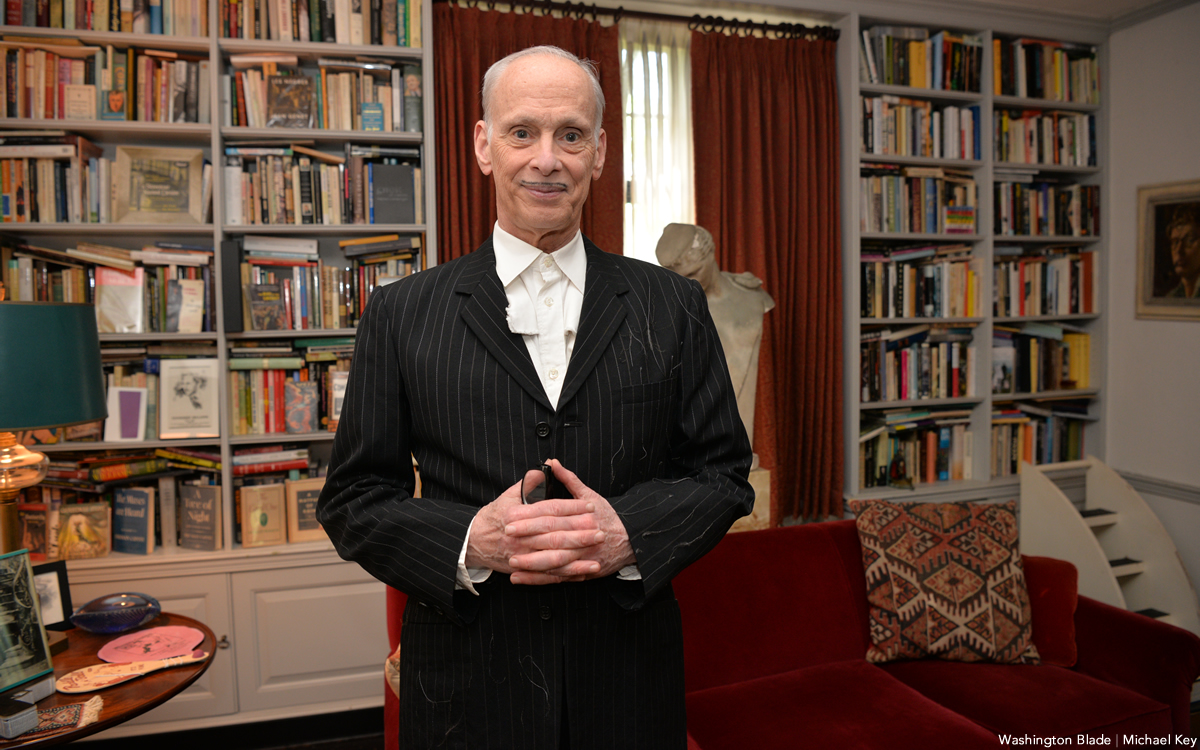
When it comes to iconic Christmas scenes in movies, none can top the tree-toppling tantrum thrown by cha-cha heels-deprived Dawn Davenport in John Waters’s fifth full-length feature “Female Trouble” from 1974. Therefore, it’s not surprising that Waters continues to make art out of Christmas, performing his spoken word Christmas tour in cities across the country. Waters has even more reason to celebrate with the release of his new red vinyl 7” single, a cover of Little Cindy’s “Happy Birthday Jesus (A Child’s Prayer)” on the A-side, and “A Pig Latin Visit From St. Nicholas” on the B-side. If you’re still looking for unique Christmas gifts, consider this record. As always, John was kind enough to make time for an interview in advance of his tour dates.
BLADE: John, in preparation for this interview with you, I went back and listened to Little Cindy’s original rendition of “Happy Birthday Jesus (A Child’s Prayer)” on your “A John Waters Christmas” CD.
JOHN WATERS: One thing I did, if you notice, I make the same stumble in my recording that she did in the original.
BLADE: It sounded to me like she got choked up.
WATERS: No, I think she just stumbles over a word, so I stumbled over the same word. It’s appropriation, insanely.
BLADE: Is this a song you first became aware of in your youth or when you were an adult?
WATERS: When I was doing the Christmas album, I had this friend named Larry Benicewicz. He was kind of my idea man with music. He knew every single old record. I would say to him, “Weird Christmas songs,” when we were doing a soundtrack, or a song about bears, or a song about this, and he would give me all these tapes. It was one of the ones he played for me. A lot of the songs I put in my movies and on my records, I did know as a kid. I did not know this one, but I immediately embraced it. I don’t think it’s campy. I think it really is spiritual in a weird way. My doing it makes it a novelty record. I am really for novelty records, and there aren’t any anymore. Why was there not a COVID novelty record? That’s insane. The dance “The Bug” that’s on the “Hairspray” soundtrack would be perfect for COVID.
BLADE: The thing that struck me was that for a Christmas song in the voice of a child, a kind of death pall hangs over it, with lines like, “If I was good you’d let me live with you” and “they nailed you to the cross, they wanted you to die.”
WATERS: All of it! When I see children at midnight mass kneeling in front of a nude man nailed to a cross, I feel like I’m at The Eagle! It is S&M, it’s creepy. I took the same cover (photo) from her record to parody and put my face on it. The same thing I did with The Singing Dogs last year when I covered (their version of) “Jingle Bells.” I’m really into novelty records. I love them and I’m trying to bring them back. I don’t expect anybody to ever play these records. Even The Singing Dogs one said on it, “Please do not play this record” [laughs]. And the flipside, the Pig Latin version, is almost impossible to listen to.
BLADE: I’m so glad you mentioned that. “A Pig Latin Visit From St. Nicholas” reminded me of the lost art of speaking in Pig Latin. I also recall watching the PBS series “Zoom” as an adolescent and learning to speak “ubbi dubbi,” a distant relative of Pig Latin. Do you think that the time is right for a Pig Latin or ubbi dubbi revival?
WATERS: Here’s the thing, I never could pick up any language, except Pig Latin. I’ve been in every foreign country. Foreign countries have given me money to learn to speak the language. I can never do it! But Pig Latin…my parents and other parents in the ‘50s spoke Pig Latin so kids couldn’t understand what they were saying. Then my mother taught it to me, and I used it. The hardest take to shoot in “Pink Flamingos” was not eating the dog shit. It was when the cast skipped, in one take, saying “E-way, are-yay e-they ilthiest-fay eople-pay in-hay e-they ole-hay ide-way orld-way.” We’re the filthiest people in the whole wide world in Pig Latin. We had to do so many takes so they could do it once without screwing it up. In “Polyester,” Edith (Massey) answers the phone, “ello-hay.” I did a photo piece where it was all subtitled in Pig Latin. Like “osebud-Ray” (from “Citizen Kane”) or in “Streetcar,” “ella-Stay!” [Laughs] All the iconic dialogue translated into Pig Latin. My assistant who helped me do it, had never heard of Pig Latin. She really got good at it because she lived in many foreign countries and can pick up languages. But it’s not that easy to do it correctly and read it. Your computer will translate into Pig Latin.
BLADE: AI understands Pig Latin?
WATERS: I guess that’s AI. It wasn’t 100% right, but it was close. I can speak it if I look at it, but just do a bit at a time. It was a challenge that no one would possibly care about or want to do.
BLADE: I think you pulled it off very well.
WATERS: If you want people to leave on Christmas morning, you put it on. That’s how you get your guests to leave. It’s time to go.
BLADE: Ood-gay i-bay! How did your relationship with record label Sub Pop, which released 2021, 2022, 2024, and new 2025 holiday singles, come about?
WATERS: I believe the first thing I did for them was “Prayer to Pasolini.” They came to me through Ian Brennan. He’s won a couple Grammys for World Music, but he is also is one of my agents who does the Christmas tour and a lot of my shows, anything with music. He helped me arrange each one of the songs. He had a relationship with Sub Pop. It was perfect. My friends in Baltimore, (the band) Beach House, have had huge success.
BLADE: That’s right, they’re on Sub Pop!
WATERS: Yes! I’m happy to be on it. I’ve even been to the warehouse and posed for pictures like Jackie Suzanne used to do.
BLADE: Is there any chance that “A John Waters Christmas” might be reissued on vinyl by Sub Pop?
WATERS: No. It’s such a nightmare to get the rights and to renew them. You have to find the publisher and the writer, and they usually hate each other. It doesn’t matter if it’s obscure or famous, it’s hard to get. You have to make the deal. The singer doesn’t get anything unless they play it on the radio. It would be so complicated legally, and there would be such a [laughs] tiny audience for it. I hope it will come out again. The same thing with the one for Valentine’s Day. I had two of them that did quite well when they came out; “A Date With John Waters and “A John Waters Christmas.” The “John Waters Christmas” album is still the soundtrack that plays whenever I’m doing my spoken word Christmas show as people are entering the theater.
BLADE: Aside from your annual Christmas show tour, what else do you do for the holidays now, and are there any traditions that you’ve carried over from your family?
WATERS: Certainly! I have two sisters, my brother’s widow, and me, so there are four and we take turns each year to have the Christmas dinner. Mine was last year. An entire sit-down dinner. Mom’s China, the silverware, the entire full dinner. It’s pretty traditional. I don’t have a Christmas tree, but I do decorate the electric chair from “Female Trouble.” That is a tradition in my family. We do have Christmas decorations, but they’re usually weird ones that fans sent me. I have one with Divine knocking over the Christmas tree, and the Christmas tree lights up, all sorts of amazing things. There is definitely a tradition here that might be a little altered, but it is definitely a tradition. I used to have a giant party every year, but COVID ended that. I still wouldn’t want 200 people in my house breathing right now.
BLADE: I was looking at your tour schedule and wondered if there are any new cities in which you’ve never performed the John Waters Christmas show that have been added to this year’s schedule?
WATERS: I don’t think there’s a city in America in which I haven’t done one show! The only places I haven’t been to are Hawaii and Alaska. I could do it there, but it’s too long on a tour. I can’t think of a city I haven’t played in in America over the last 50 years. The Christmas show is completely different every year. It doesn’t matter if you saw it last year.

Some gifts scream practical, others whisper luxury, and a few flat-out blur the lines. From cocoa that feels ceremonial to a cologne that linger like a suggestive smirk, this year’s ultimate gift picks prove that thoughtful (and occasionally naughty) presents don’t have to be prosaic. Welcome to your holiday cheat sheet for festive tangibles that get noticed, remembered, and maybe even result in a peck of gratitude planted under the mistletoe. Consensually, of course.
Amber Glass Champagne Flutes
Pop the champs – but make it vintage. These tulip-shaped stunners in amber-tinted glass bring all the Gatsby vibes without the Jazz-age drama. Whether you’re toasting a milestone or celebrating a Tuesday, their seven-ounce capacities and hand-wash-only care make ‘em as practical as they are pretty. Pair with a thoughtful bottle of bubs and gift with a glittering wink. $18, NantucketLooms.com
Disaster Playbook by Here Comes the Apocalypse
Because the end of the world shouldn’t be a solo act, this spiral-bound guide is your step-by-step roadmap to surviving and thriving when everything else goes sideways, which might be sooner than you think. Packed with checklists, drills, and a healthy dose of humor, it’s like a survival manual written by your most prepared (and slightly snarky) friend. Whether you’re prepping for a zombie apocalypse or, more realistically, REVOLUTION!, this playbook’s got your back. $40, HereComesTheApocalypse.com

Wickless Vulva Candles
Bold, luxurious, and completely flame-free, CTOAN’s wickless candles melt from beneath on a warmer, releasing subtle, sophisticated fragrances, like sandalwood or lavender. The vulva-shaped wax adds a playful, provocative element to any space –perfect for a bedroom, living room, or anywhere you want elegance with an edge. A gift that celebrates form, intimacy and self-expression, no fire required. $39, CTOANCO.com
Villeroy & Boch Royal Classic Christmas Collection
Every meal is a mini celebration – with whimsy at every place setting – in Villeroy & Boch’s Royal Classic festive dinnerware collection that hits all the right notes. Made from premium German porcelain, it features nostalgic little toys, nutcrackers, and rocking horses in delicate relief, giving your holiday spread a playful but refined twist. Dishwasher- and microwave-safe, it’s luxe without the fuss. Gift a piece to a special someone, or start a collection they’ll use (and show off) for years to come. $22-$363, Villeroy-Boch.com
Greenworks Electric Lawnmower
You a ’hood queen who considers lawn care performance art – or just wants to rule the cul-de-sac in quiet, emission-free glory? Greenworks’ zero-turn electric mower has the muscle of a 24-horsepower gas engine but none of the fumes, drama or maintenance. Six 60V batteries and a 42-inch deck mean you can mow up to two-and-a-half acres on a single charge – then plug in, recharge, and ride again. It’s whisper-quiet, slope-ready, and smooth enough to make you wonder why you ever pushed anything besides your queer agenda. The perfect gift for the homeowner who loves sustainability, symmetry, and showing off their freshly striped yard like that fresh fade you get on Fridays. $5,000, GreenworksTools.com
Molekule Air Purifier
For the friend who treats their space like a sanctuary (or just can’t stand sneezes), the Molekule Air Pro is magic in motion. Covering up to 1,000 square feet, it doesn’t just capture allergens, VOCs, and smoke – it destroys them, leaving your air feeling luxury-clean. FDA-cleared as a Class II medical device, it’s serious science disguised as modern design. Gift it to your city-dwelling, pet-loving, candle-burning friend who likes their living room as pristine as their Instagram feed. $1,015, Molekule.com

Cipriani Prosecco Gift Set
Effervescent with stone-fruit sweetness and a touch of Italian flair, the Cipriani Bellini & Prosecco gift set brings brunch-level glamour to any day of the week. The Bellini blends rich white-peach purée with sparkling wine, while the dry ’secco keeps things crisp and celebratory. Pop a bottle, pour a flute, and suddenly winter weeknights feel like a party – even with your pants off. $36, TotalWine.com
Woo(e)d Cologne
British GQ recently crowned Woo(e)d by ALTAIA the “Best Date Night Fragrance,” and honestly, they nailed it. Confident without being cocky – smoky gaïac and Atlas cedarwood grounds the room while supple leather and spicy cardamom do all the flirting – it’s a scent that lingers like good conversation and soft candlelight. Gift it to the one who always turns heads – or keep it for yourself and let them come to (and then on) you. $255, BeautyHabit.com

Lococo Cocoa Kit
Keep the run-of-the-mill mugs in the cabinet this Christmas and pull out Lococo’s handcrafted Oaxacan versions that demand you slow down and sip like it matters. Paired with a wooden scoop, rechargeable frother, and Lococo’s signature spice hot-chocolate blend (vegan, gluten-free, with adaptogenic mushrooms), this holiday kit turns Mexi-cocoa into a mini ritual you’ll look forward to. Perfect for anyone who loves a little indulgence with a side of ¡A huevo! energy.
Manta Sleep Mask
Total blackout, zero pressure on the eyes, and Bluetooth speakers built right into the straps, this ain’t your mama’s sleep mask — but it could be. The Manta SOUND sleep mask features C-shaped eye cups that block every hint of light while ultra-thin speakers deliver your favorite white noise, meditation, or late-night playlist straight to your ears. With 24-hour battery life, breathable fabric, and easy-to-adjust sound, it turns any bed (or airplane seat) into a five-star sleep suite. Perfect for anyone who treats shut-eye like an art form (or just wants to escape their roommate’s late-night bingin’ and/or bangin’). $159, MantaSleep.com

Shacklelock Necklace
Turn the industrial-chic vibe of a shackle into a sleek statement. Mi Tesoro’s platinum-plated stainless-steel necklace sits on an 18-inch wheat chain, featuring a shackle-style latch pendant that’s waterproof, tarnish-free, and totally fuss-les. Beyond style, it nods to a classic gesture in the queer leather community: replacing a traditional Master lock with something elegant to quietly signal belonging to someone special. Wear it solo for a minimalist edge or layer it like you mean it; either way this piece locks in both your look and your intentions. $90, MiTesoroJewelry.com
Parkside Flask Mojave Edition
Wine nights get a desert glow-up with Parkside’s limited-edition 750-milliliter all-in-one flask draped in sun-washed bronze and badland hues like sage, sand, and terracotta – with magnetic stemless tumblers that snap on for effortless shareability. It keeps your vino chilled for 24 hours, pours without drips (no tears for spilled rosé, please), and even lets you laser-engrave your own mantra or inside joke. Perfect for picnics, surprise rooftop clinks, or gifting to your favorite wine (or desert) rat. $149, HighCampFlasks.com
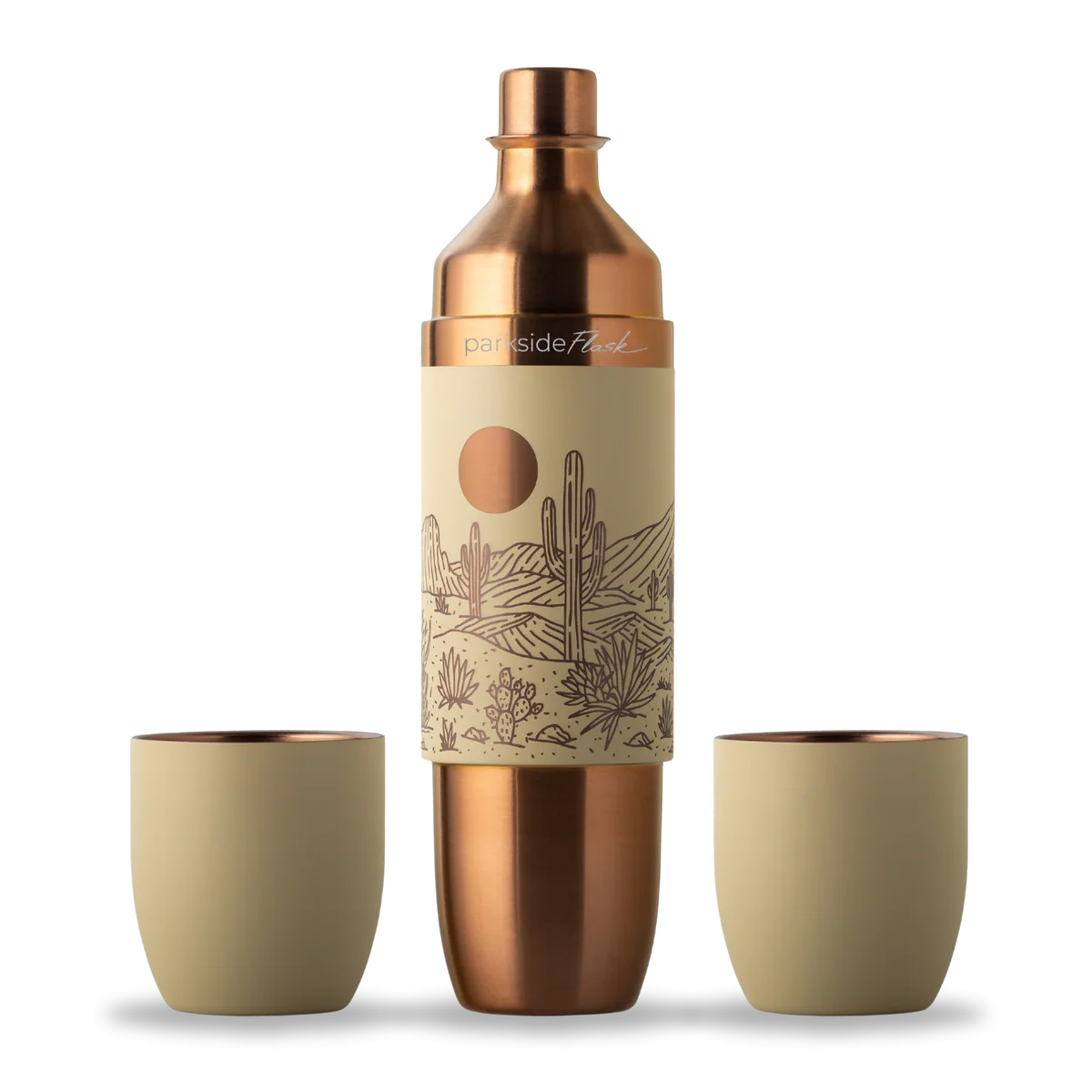
Mikey Rox is an award-winning journalist and LGBT lifestyle expert whose work has published in more than 100 outlets across the world. Connect with him on Instagram @mikeyroxtravels.
a&e features
Meet Mr. Christmas
Hallmark’s Jonathan Bennett on telling gay love stories for mainstream audiences

Jonathan Bennett believes there are two kinds of people in the world — those who love Hallmark movies and liars. And in Season 2 of Finding Mr. Christmas, which the Mean Girls star co-created with Ben Roy, Bennett is searching for Hallmark’s next leading man.
“It’s so fun for people because everyone in their life has someone they know that they think should be in Hallmark movies, right? The UPS driver, the barista at the coffee shop, the dentist,” Bennett says. “So we’re testing their acting abilities, we’re testing who they are, but we’re also looking for that star quality — the thing that makes them shine above everyone else. It’s almost something you can’t explain, but we know it when we see it.”
Season 2’s cast includes a former NFL player for the Green Bay Packers, a few actors, and a realtor. The 10 men compete in weekly festive-themed acting challenges, one of which included having to ride a horse and act out a scene with Alison Sweeney. The contestants were chosen from a crop of 360 potential men, and Bennett gives kudos to the show’s Emmy-nominated casting director, Lindsay Liles (The Bachelor, Bachelor in Paradise).
“She has a tough job because she has to find 10 guys that are going to be good reality television, but also have the talent to act, carry a scene, and lead a Hallmark movie eventually,” he says. To be the right fit for a Hallmark leading man, Bennett singles out five key characteristics: you have to be funny, charming, kind, have a sense of humor, and you have to do it all with a big heart.
Of course, Finding Mr. Christmas wouldn’t be Finding Mr. Christmas without its signature eye candy — something Bennett describes as “part of the job” for the contestants. “I can’t believe Hallmark let me get away with this. I dressed them as sexy reindeer and put them in harnesses attached to a cable 30 feet in the air, and they had to do a sexy reindeer photo shoot challenge,” he says with a laugh. “This season is just bigger and bolder than last. People are responding to not only all the craziness that we put them through, but also comparing and contrasting the guys in their acting scenes when we do them back-to-back.”
Season 1 winner Ezra Moreland’s career has been an early testament to the show’s success at finding rising talent. On seeing the show’s first winner flourish, Bennett says, “Now to watch him out in the world, just booking commercial after commercial and shining as an actor and a model, I think the show gave him the wings to do that. He learned so much about himself, and he took all that into his future auditions and casting. He just works nonstop. I’ve never seen an actor book more commercials and modeling gigs in my life.”
Bennett has been a star of plenty of Hallmark movies himself, including the GLAAD-award-winning The Groomsmen: Second Chances, which makes him a fitting host. Among those movies are 2020’s Christmas House, which featured the first same-sex kiss on the network and had a major impact on Bennett’s career as an openly gay man. “Hallmark’s been so great about supporting me in queer storytelling. But again, I don’t make gay movies for gay audiences. I make gay love stories for a broad audience, and that’s a huge difference, right? We’re not telling stories inside baseball that only the gay community will understand.”
He continues, “The backdrop of a Hallmark Christmas movie is very familiar to these people who watch. And so when you tell a gay love story, and you tell it no differently than a straight love story in that space, they’re able to understand. It’s able to change hearts and minds for people who might not have it in their lives.”
While Hallmark has become a major staple of Bennett’s career, he started off wanting to be a Broadway actor. And before the first season of Finding Mr. Christmas aired, Bennett took a break from TV to make his Broadway debut in Spamalot, replacing Michael Urie as Sir Robin and starring alongside Ethan Slater and Alex Brightman.
“That was my dream since I was five years old – then I booked a movie called Mean Girls, and everything kind of changes in your life. You no longer become a person pursuing Broadway, you become a part of pop culture,” Bennett recalls. “And to be honest, when I hit 40, I was like, ‘I’m probably never going to get to live that dream.’ And that’s okay, because I got to do other dreams and other things that were just as cool but different. So I honestly never thought it would happen.”
Bennett is still determined to make his way back on Broadway with the right role — he calls Spamalot the “best experience” of his life, after all — but he’s got another Hallmark show lined up with Murder Mystery House, which he co-created. The show was recently greenlit for development and intends to bring the Hallmark mystery movie to life. “It’s kind of like our version of The Traitors,” Bennett admits.
Looking back on both seasons, Bennett says that what makes Finding Mr. Christmas stand out in the overcrowded reality TV landscape is that everyone involved makes it with heart: “This isn’t a show where you’re going to watch people throw drinks in each other’s faces and get into big fights. The thing that has amazed me so much about this show, the more we’ve done it, is that every season, 10 guys come in as competitors, but they leave as a family and as brothers. That’s something you don’t get on any other network.”
Finding Mr. Christmas airs every Monday on Hallmark through December 20, with episodes available to stream on Hallmark+.





